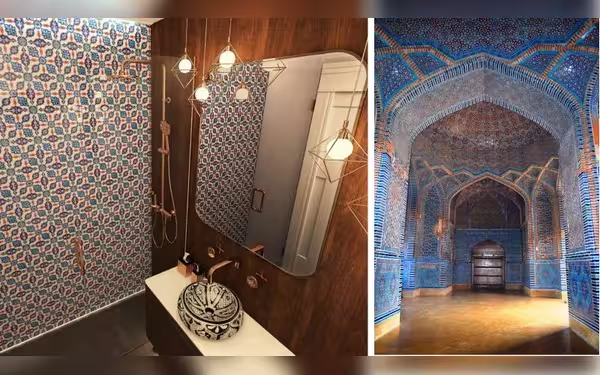Thursday, July 4, 2024 05:36 PM
Artisans in Hala Preserve Traditional Tile Craft
- Hala tiles blend Persian techniques with local designs and vibrant colors
- Crafting Hala tiles requires skilled artisans and intricate, labor-intensive processes
- Renewed interest in traditional crafts like Hala tiles is driven by cultural heritage appreciation
 Image Credits: thefridaytimes
Image Credits: thefridaytimesExplore the rich tradition of crafting Hala tiles in Sindh, blending Persian techniques with local designs and vibrant colors. Discover how skilled artisans preserve this cultural heritage through intricate processes and innovative approaches.
Hala, a town nestled along the Indus River, has long been a center of artistic ingenuity and craftsmanship. The tradition of crafting tiles in Hala traces its roots back to the Mughal era, where the art of glazed tile work, known as kashi, flourished under royal patronage. Influenced by Persian techniques, Hala tiles have evolved into a unique form characterized by local designs and vibrant colors.
The process of creating Hala tiles is intricate and labor-intensive, requiring skilled artisans who have inherited their expertise through generations. It commences with selecting premium clay, which is then molded and shaped before being coated with a white glaze as a canvas for intricate patterns. Artisans meticulously paint these patterns using natural pigments, drawing inspiration from floral, geometric motifs, and traditional Sindhi art.
The rich hues of cobalt blue, turquoise, green, and yellow lend Hala tiles their distinctive charm. Firing the painted tiles in kilns at precise temperatures not only strengthens them but also preserves the colors and designs, ensuring longevity. These tiles adorn mosques, shrines, and palaces in Sindh, reflecting the region's rich artistic heritage.
With religious and social symbolism embedded in their designs, Hala tiles feature Quranic verses, floral imagery symbolizing paradise, and geometric patterns representing the universe's vastness. The craft of Hala tile making has endured over time, with artisans passing down their skills to future generations.
In recent years, a renewed interest in traditional crafts like Hala tiles has emerged, driven by a growing appreciation for cultural heritage and sustainable handmade products. Efforts to revive this craft through workshops, exhibitions, and training programs have gained momentum, supported by various organizations and government initiatives.
Despite challenges such as sourcing quality clay and competition from mass-produced tiles, artisans are embracing modern technologies and marketing strategies to sustain and expand their craft. The fusion of Hala tiles into contemporary designs for homes, restaurants, and public spaces exemplifies a seamless blend of traditional craftsmanship with modern aesthetics.
The art of Hala tiles stands as a testament to the enduring legacy of craftsmanship in Sindh, bridging the past with the present through its intricate designs and vibrant colors. As these artisans continue to preserve and innovate their craft, Hala tiles not only embellish architectural marvels but also serve as cultural treasures that resonate with the essence of tradition and creativity.













